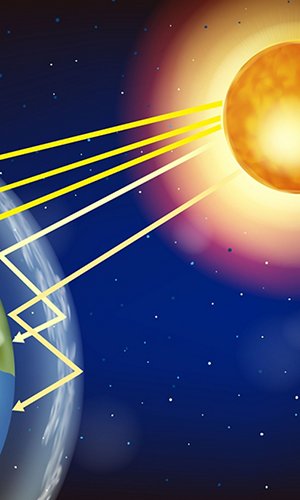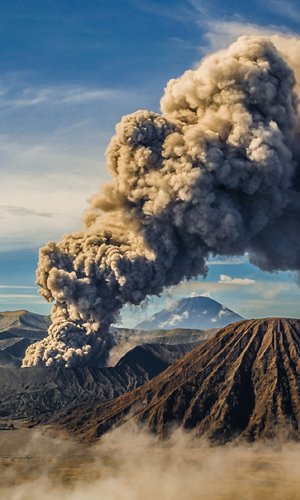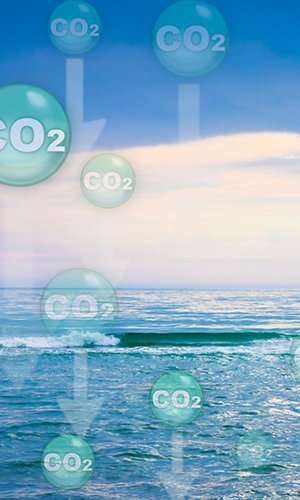The weather has a permanent influence on our lives. The sky is often the first thing we look when we wake up in the morning. Pressure and humidity affect our body and mood; who has never said “today I am depressed: I should probably blame it on the rain?”. At least once a day most of us want to see or hear a weather forecast and ever since we were born we are used to season cycles that regulate the biologic cycles of all living beings. Popular sayings have been invented about the weather that often sound silly; but the sentence “seasons no longer are the way they used to be”, no matter how old a complaint, because Virgil said it 2000 years ago, has never seemed so a propos as in the past years. In the last years, in fact, we have had springs that seemed like summers, winters that seemed like autumns and meanwhile the media keep telling us about greenhouse gasses and global warming, environmentalists give catastrophic forecasts for the future, while scientists and politicians are obviously trying to calm the alarmism. In all this great confusion it is always us “normal people”, to be left without any clear ideas and so it is our duty to at least try to understand a little bit better the way how things actually stand.
Voice search

The word climate derives from the Greek word κλιμα, or inclination. Climate, in fact, is partly determined by the inclination of the sun’s rays on the Earth’s surface, which varies with the latitude and seasons. The term “climate” is often used as a synonym of meteorological “weather” even though their meanings are quite different. Meteorological weather is the set of meteorological elements that characterize the atmosphere at a precise moment. If we look out of the window we can immediately see what the weather is like. The climate, instead, is defined as the “set of meteorological phenomena (e.g. temperature, precipitation, winds, etc.) that characterize the average state of the atmosphere at a particular point of the Earth’s surface”, (according to the definition given by J. Hann an Austrian meteorologist). Due to the extreme variability of meteorological parameters, the World Meteorological Organization has established that, in order to identify climatic characteristics, and therefore the “average state of the atmosphere”, of a particular location, the minimum duration of the historical time-series of meteorological data must be at least 30 years. The discipline that studies the climate, its elements and its factors, and classifies the types of climate is called climatology.
Related topic
Sun and climate
If the Earth rotated around the sun in a perfectly vertical way like a spinning top, the weather wouldn’t vary during the year, in other words there wouldn’t be any seasons, because the amount of solar radiation reaching the planet’ surface would always be the same. If the earth’s axis wasn’t at an angle with respect to the orbital plane, not only would there be no seasons, but neither could there be any differences between one hemisphere and the other and obviously the tropics would not exist.
Radiation balance on Earth
Apart from a small amount of energy that comes from inside the Earth, the energy that feeds the climate system of our planet comes mainly from the Sun. In fact the Earth receives the radiant energy of the Sun (i.e. transported by electromagnetic radiation), about half of which is visible light, a small part is ultraviolet light, and the remaining part is infrared light. The solar radiation that hits the Earth’s surface in one hour is equal to approximately 342 w/m2; out of which only 235 w/m2 are actually absorbed by the Earth’s surface, while the remaining 107 are immediately reflected into space.
Read more...
As already mentioned in the previous paragraphs, the greenhouse effect is a natural phenomenon, provoked by a mixture of gases that are present in the atmosphere (and defined greenhouse gases) without which there would not be any life on the Earth. In the last century, however, the intense human production activities led to an increase in the concentration of “greenhouse gases” in the atmosphere. There are two main causes: on one hand the increasing amount of emissions originated prevalently by the traditional processes for the production of energy (fossil fuels); on the other, the progressive destruction of the forests which, thanks to plant chlorophyll photosynthesis, can “absorb” the carbon dioxide in the air and transform it into organic material (leaves, branches and roots), acting as true “tanks” or “sinks” for carbon dioxide. If the concentration of greenhouse gases continues to increase at the rhythm of the last decades, there is the risk that a rapid warming in the Earth’s climate may be triggered, because the capacity of the atmosphere to hold back the heat on the Earth is increasing progressively. An excessive increase in a short period of time, of the temperatures of the atmosphere and of the oceans, would have dramatic effects on the climate balance and a remarkable impact on human beings.
According to some climate experts, if human behaviour does not change, in the next 100 years the Earth’s temperature may increase an average of 1.0 to 3.5°C.
Other data give us an indication of the variations which occurred in the past century: from the industrial revolution to date, the concentration of carbon dioxide in the atmosphere has increased 30%, during the same period the concentration of methane, emitted principally by the rice fields and cattle farms, has increased 145%. Many experts, appointed by national and international organizations, among which IPCC (Intergovernmental Panel on Climate Change) have, since some years, been monitoring the climate of our planet and studying the possible effects of the increase in temperature of the lower atmosphere and of the Earth’s surface, which will be examined in detail in the following paragraph.
Related topic
Consequences of climate changes
Based on the researches of the International Organism that studies climate changes, IPCC (Intergovernmental Panel on Climate Change), the increase in the concentrations of greenhouse gases in the atmosphere is the main cause of the intensification of the following phenomena:
- Increase in Planet temperature.
- Increase in the precipitation: mainly in the Northern Hemisphere, and in particular in the middle and high latitudes. In the tropical and subtropical regions, instead, a decrease in the amount of rain…
Greenhouse gases
Natural greenhouse gases include water vapour, carbon dioxide, methane, nitrogen protoxide and ozone. Some human activities contribute to the increase in the concentration of these gases in the atmosphere and, furthermore, they free other greenhouse gases that are exclusively anthropogenic in the air. Let us now examine the characteristics of the principal gases which have a greenhouse effect, in detail:
Water vapour. Water vapour is the principal greenhouse gas, it is responsible for 2/3 of the natural greenhouse effect, due to its abundance in the atmosphere and due to its efficacy.
Comparing greenhouse gases
In order to calculate the contribution of the different gases to the greenhouse effect, three fundamental parameters must be taken into consideration:
- concentration in the atmosphere;
- radiative forcing of each gas, i.e. the capacity to trap the energy going from our Planet into Space;
- persistence in the atmosphere of each gas, i.e. the mean time the gas remains in the atmosphere.
When the greenhouse effect “born”
In 1824 the French scientist Jean Baptiste Fourier, who made some famous discoveries in physics and mathematics, was the first one to talk about “greenhouse effect” and measure it with the helium thermometer. The theory is that the atmosphere acts as the glass enclosure of a greenhouse, which lets solar rays through while it tends to trap the thermal rays which are released by the planet’s surface. Thanks to this, Earth’s average temperature is stable around 15°C, instead of approximately the -19°C that it would be without “greenhouse gasses”.
What is the IPCC?
Since the end of the Eighties, scientists have become aware that the great amount of human-induced greenhouse gas emissions was causing an increase in the greenhouse effect, and consequently, significant changes in climate which could trigger many problems. In order to have a clearer and more thorough knowledge of the situation, the World Meteorological Organization (WMO) and the United Nations Environment Programme (UNEP) created the IPCC, the Intergovernmental Panel on Climate Change.
Read more...
Since the Earth’s origin, about 5 billion years ago, there have been alternating cold periods which culminated in numerous glacial episodes that lasted millions of years, and periods of temperate or warm climate, lasting hundreds of millions of years. The climate has deeply conditioned the life of living beings inhabiting the Earth, and with each variation, plants, animals and humans have had to adapt, even to the most inhospitable environments. Therefore there have always been climatic variations over the centuries, but it is important to analyze the extent of the variations, in other words how much they influence our life and their duration. If we consider the personal experience of the life of a human being, we can observe seasonal or annual variations, for example warmer years or years in which the rainfall was more abundant than in others. Over the centuries, in fact, there have been climatic variations that were much greater than those of today. A rise in temperature is always associated with melting Polar and Continental ice, with a consequent increase in the sea levels. In the past 500 million years, there have been variations in the sea level of even hundreds of metres, compared to the current levels (200-300 metres). However these changes took place over a very long period of time, about 300 million years, and therefore were not noticeable during the human life-span.
Related topic
Quaternary or glacial era
Major climate variations have taken place during the Quaternary period (the past 2,5 million years), which is when man made his first appearance on Earth, caused by the massive expansion of the polar caps approximately every 100 thousand years, that made the sea level decrease by as much as 120 – 140 meters below what it is today. We must bear in mind that the last glaciation allowed man to spread all over the world, thanks to the spits of dry land emerging from the lowered sea level.
The year without a summer
During the Roman era the climate was rather warm, and we have proof of this from the pools that Ancient Romans used to breed eel. In fact these pools had two holes, one at high tide level and the other at low tide level. At high tide fresh sea water would come in through the first hole while stagnant water left the pool through the second one at low tide, so that the pools had a constant fresh water turnover which worked the same way as modern day aquarium filtering systems.
The myth of luxuriant Greenland
The example of Greenland is often mentioned, to show the climate changes caused by man. About one thousand years ago the Viking Erik the Red called the largest island in the world “Grönland”, or “green land”. 84% of its surface today is covered with ice. In 982 A.D. the Viking escaped from the south-western part of Norway, his native land, due to some homicides, and he ventured towards unknown faraway lands. He first reached Iceland and then Greenland.
From hot to cold
We have all read about the Medieval Warm Period and the Little Ice Age in the newspapers and books. These terms, which are now commonly used, were introduced by the climate-historian Hubert Lamb in 1965 and by the glaciologist Francois Matthes in 1939, respectively. Climate historians and paleoclimatologists, however, do not agree on the time and duration of these periods and also the estimates of the variations in the temperature that characterized them are different.
“Frozen” Thames
Since there has been a continuous alternation of very cold periods and very hot periods in the past, some believe that the current variations in temperature are quite natural and negligible. In this way the importance of climate changes is minimized and it is “convenient” to believe that this is an invention of the media. As proof of a past that was much colder than today, the frozen Thames is often mentioned. The Thames, in fact, used to freeze often during the cold season, but this has not occurred since the winter of 1814.
Venice on ice
Another example which has been mentioned to prove the cold in the Little ice age is the frozen Venice lagoon. There is a large amount of written evidence about the difficulties caused by the intense cold during the winter of 1788-1789, even in paintings showing boats stuck in the ice, which prevented supplies of goods and navigability. Actually the lagoon of Venice has frozen many other times, even after the so-called Little Ice Age.
Read more...
Core boring is a sampling technique used to research mineral resources in the subsoil by boring wells in order to analyze the ground, and for other digging activities for civil engineering purposes. In core boring a cylinder shaped sample of rock or ice is extracted, which is known as a core. From these cores it is possible to obtain a large amount of information on the climate variations of the past, thanks to what remains imprisoned in the ice, such as: gas bubbles, chemical elements that form the ice, sediments, fossils and many other elements. These traces are true witnesses of past periods, and are useful in order to reconstruct the climatic history of the Earth. Ice cores, in fact, maintain the chemical and isotopic characteristics obtained from the snow in the atmosphere at the time of condensation and precipitation, characteristics that remain mostly unaltered in the ice. Ice core boring is possible in the internal areas of Greenland and the Antarctic as the temperature always remains below zero and therefore the is no surface fusion, and the snow that accumulates each year forms a regular and continuous stratigraphic succession of layer upon layer of snowfall. With the passing of time the snow is compacted and the empty spaces are decreased and the snow is transformed first into firn or névé and then into ice, the pores become occluded and the air bubbles are trapped and therefore provide samples of the atmosphere in the past.
Related topic
Fossil pollens
The study of pollens can reconstruct the history of vegetation in the past, and therefore of climate changes in time. For example we can imagine a fossil lake, preserved in different sediments, just like a filing cabinet with many drawers: each layer is a drawer containing the pollens of all the plants that grew at that particular time in the surrounding area. There are plants, in fact, that are considered climatic indicators – in other words they live in a particular region only if the climate is suited to their needs.
Isotopic stratigraphy
Isotopic stratigraphy is based on the study of isotopes, especially carbon and oxygen isotopes. This technique can be used to study variations in temperature, salinity and volume of masses of ice in time. Generally, planktonic and benthonic foraminifera living in the surface layers of the sea or in sea sediments, are studied. After treating the organisms with the help of a specific instrument, the isotopic ratio of “heavy” oxygen-18 and normal oxygen-16, contained in the calcite shells of the foraminifera, is measured.
Geological traces
In certainly is no easy task to retrace all the sea level variations that have happened in thousands of years. Several different geological techniques which focus on studying specific areas near the coastlines have been used to trace these variations. The sea digs a horizontal crevice at water level at the base of a cliff which becomes deeper as time goes by. When the sea level decreases, it makes a new etching. Sea level variations can be discovered by measuring the height difference between these two marks.
Climate variations
If we have many geological markers we can draw a eustatic graph which traces the different sea levels over the millennia. For instance, 220,000 years ago the sea was 3 meters below its current level and about 140,000 years ago it was as much as 140 meters below its level nowadays. Right after that, during the Tirrenian period about 125,000 years ago it rose suddenly to 7 meters above today’s level. That was a very warm period, much warmer than it is today and with a much higher concentration of carbon dioxide.







